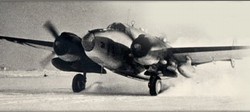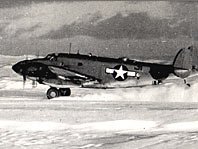Wreck Found in Russia: "Bomber 31"
 On
March 25, 1944, a U.S. Navy bomber disappeared into the fog over
the Bering Sea heading for a Japanese target. Fifty-five years
later it has suddenly reemerged with a remarkable tale. NOVA
traveled to the plane's final resting place to unravel the mystery.
Using clues found at the crash site and the latest forensic
techniques, a U.S. government team got to the bottom of this
half-century-old disappearance.
On
March 25, 1944, a U.S. Navy bomber disappeared into the fog over
the Bering Sea heading for a Japanese target. Fifty-five years
later it has suddenly reemerged with a remarkable tale. NOVA
traveled to the plane's final resting place to unravel the mystery.
Using clues found at the crash site and the latest forensic
techniques, a U.S. government team got to the bottom of this
half-century-old disappearance.
 Taking off from Attu in the Aleutian Islands at
the height of World War II, Bomber 31 was on its way to attack a
Japanese outpost guarding the northern approach to Japan's main
islands. The mission was part of a largely forgotten campaign in
the Pacific war -- a bold diversion to convince the Japanese that
American forces were preparing to invade from the north, forcing
the imperial command to deploy valuable resources to defend that
front. At the same time, Allied forces under General Douglas
MacArthur were making the main push from the south.
Taking off from Attu in the Aleutian Islands at
the height of World War II, Bomber 31 was on its way to attack a
Japanese outpost guarding the northern approach to Japan's main
islands. The mission was part of a largely forgotten campaign in
the Pacific war -- a bold diversion to convince the Japanese that
American forces were preparing to invade from the north, forcing
the imperial command to deploy valuable resources to defend that
front. At the same time, Allied forces under General Douglas
MacArthur were making the main push from the south.
Of the five planes in Bomber 31's squadron, one crashed on
take-off, and three completed the mission. Bomber 31 and its
seven-man crew went missing for more than half a century.
Then in 1999 the U.S. embassy in Moscow received a surprising
package: half a dozen photographs taken by a Russian historian,
showing the wreckage of a World War II-era American bomber
discovered on the slope of a volcano on the Kamchatka Peninsula in
eastern Siberia. How the plane got there and what happened to its
crew are mysteries that only deepened as NOVA arrived with
investigators from the United States to explore the remains -- the
first recovery team of its kind allowed in Russia.
Kamchatka was super-secret Cold War territory.
 At the outset, all that was known for certain was
that this was Bomber 31, confirmed by the type of aircraft -- a
U.S. Navy PV-1 -- and the faded "31" stenciled on the tail. The
party included a ten-person U.S. Army recovery team, headed by
forensic anthropologist Ann Bunch. Also participating were Ralph
Wetterhahn, a Vietnam veteran and military crash investigator, and
Tom Rains, who was only ten months old when his father disappeared
on Bomber 31's final mission.
At the outset, all that was known for certain was
that this was Bomber 31, confirmed by the type of aircraft -- a
U.S. Navy PV-1 -- and the faded "31" stenciled on the tail. The
party included a ten-person U.S. Army recovery team, headed by
forensic anthropologist Ann Bunch. Also participating were Ralph
Wetterhahn, a Vietnam veteran and military crash investigator, and
Tom Rains, who was only ten months old when his father disappeared
on Bomber 31's final mission.
The trail of evidence led to a strange story told by a Russian
geologist who chanced on the wreckage in 1962 and remembers finding
four bodies. Alerted to the presence of the plane, the KGB
took charge and probably dispersed the wreckage to disguise it from
U.S. spy satellites. What they did with the bodies is a mystery.
After scouring the site, the recovery team found small bits of
bone, which were sent to the United States for DNA analysis in
hopes that the half-century-old fragments could be matched to
relatives of missing crew members.
Also at the crash site, Wetterhahn found telltale evidence of
the plane's last moments. Battle damage on the engines shows that
Bomber 31 was in distress, and an unexploded bomb implies that it
had not performed its mission.
Working backward from Bomber 31's assigned target -- the
Japanese base at Shumshu in the Kuril Islands -- Wetterhahn took
NOVA through a likely scenario that brought the plane and crew to a
daring landing and a heroic last struggle.
[Local listings for the re-airing of this feature are displayed
at the website.]
 ANN's Daily Aero-Term (12.01.25): Convective SIGMET
ANN's Daily Aero-Term (12.01.25): Convective SIGMET ANN's Daily Aero-Linx (12.01.25)
ANN's Daily Aero-Linx (12.01.25) NTSB Final Report: Remos Aircraft GmbH Remos GX
NTSB Final Report: Remos Aircraft GmbH Remos GX Aero-News: Quote of the Day (12.02.25)
Aero-News: Quote of the Day (12.02.25) ANN's Daily Aero-Term (12.02.25): Coupled Approach
ANN's Daily Aero-Term (12.02.25): Coupled Approach




